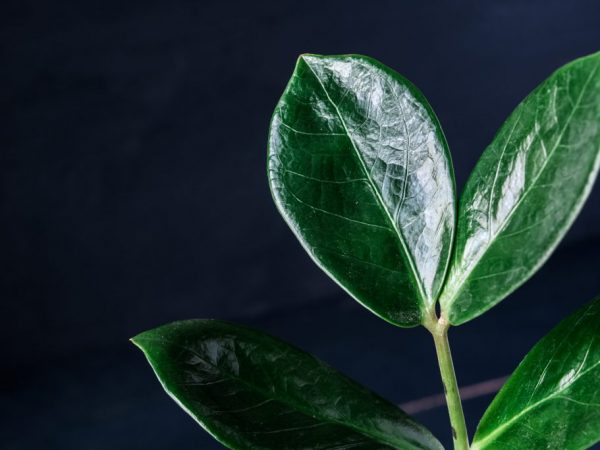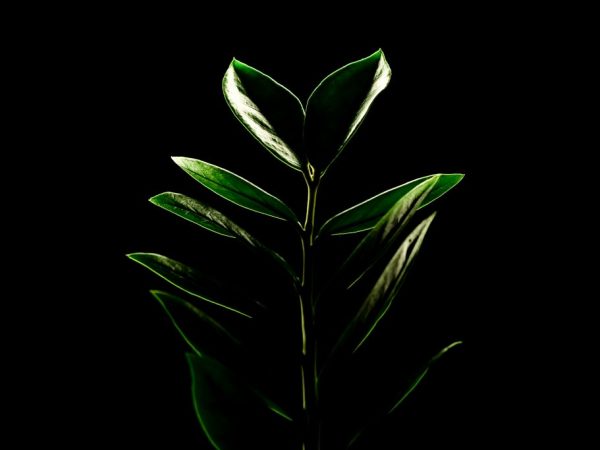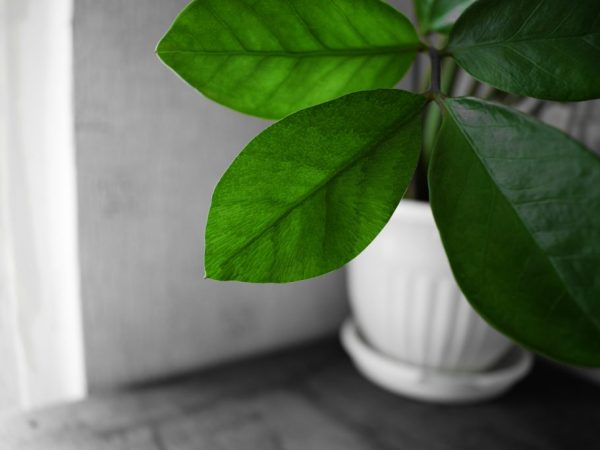Black zamioculcas - a beautiful dollar tree
Black zamioculcas, or Raven, is a "dollar tree" variety grown in Dutch nurseries just a couple of years ago. During the period of active growth, he is no different from his brothers with green leaves. But with age, the leaf blades and stems acquire a black color, hence the name "raven", which means "Raven".

Black zamioculcas - a beautiful dollar tree
Description
Black zamioculcas is ideal for interior decoration, because it stands out for its decorative effect.
The leaves are glossy, black-purple in color, reminiscent of the spread wing of a raven, because they have a rounded-pointed shape and are arranged symmetrically along the length of the stem, like feathers. The natural waxy coating is similar to varnish, which gives the tree a luxurious look.
The variety grows at home up to 1.5 m in height. Young shoots are pale green, but in the sun they acquire a black tint, starting from the tips. When grown in partial shade, the color of the shoots and leaves remains green.
The plant blooms rarely, with proper care and in adulthood. The flower looks like a leaf at first and then resembles an ear of corn.
Purchase and adaptation
When choosing a plant, pay attention that it does not dangle in the pot, does not have spots, the leaves should not crumble when shaken.
After the purchase, zamiokulkas are placed for 10-15 days separately for acclimatization and quarantine in case a sick flower is sold to you
Next, the tree can be transplanted into a permanent pot with new soil. The transport substrate for the store is not suitable for life. In the end, it remains only to establish the usual care.
Landing
For planting, you should choose a pot a couple of centimeters larger than the old one, which will save you from stagnation of moisture in the ground and underdevelopment of the aboveground part, which grows only after filling the entire volume of the container with roots.
The best option is a wide flowerpot, narrowed downwards. Florists recommend opting for a plastic pot.
Expanded clay is poured at the bottom of the container, and the tree itself is carefully transplanted by transshipment.
Transfer:
- The procedure is annual for up to 3 years. And then - once every 2 years.
- From the age of six, it is enough to carry out the procedure every five years, but the top layer of the earth should be periodically changed.
A signal about the need for a transplant - the roots fill the entire volume of the pot and germinate outward. Do not transplant the plant during the flowering period.
The necessary conditions
Selection of soil and location

The flower should not be placed in direct sunlight
For planting, an ordinary universal soil mixture or a special one for succulents is suitable. You can also prepare the soil yourself from the earth, sand and peat calcined in the oven, mixing in equal parts.
It is also recommended to add a little crushed sphagnum or expanded clay - zamiokulkas loves loose and light substrates, where air can easily penetrate.
You can put the pot in any corner of the room, but it is important that the light is diffused. With age, the bush increases significantly in size, so it is most often placed in a tub on the floor.
Microclimate
| Humidity | Temperature | Lighting |
| The flower treats dry air well, but reaches its maximum growth and beauty at relatively high humidity. In the summer heat and during the heating season, regular spraying will be required. | Optimal conditions are room temperature, not lower than 16⁰С. But the cold can provoke disease. The plant should be protected from drafts. | Zamioculcas is not picky about light and can even stand on the shady side and northern windowsills. But the plant has sensitive leaves, so they are shaded from direct sunlight, otherwise burns will form. Diffused light for at least 6 hours a day is the best solution. |
Home care
Zamioculcas does not require complex care and is quite tenacious in different conditions.
- Every three weeks after watering, fertilizing is carried out. Choose special fertilizers for succulents. The best way is spraying. Do not add additives during the dormant period, that is, from October to February-March.
- It is best to water the flower rarely, but abundantly. Excess moisture is worse than deficiency. To determine the need for the procedure, you can touch the soil: if it is completely dry, then the time has come. The water must be clean and settled.
Additional recommendations
When growing, branches may require support - tall shoots tend to bend under their own weight.
Leaves and shoots should be looked after carefully - milky juice can cause allergies.
If the zamioculcas has released buds, but does not form new leaves, then it may be aging. In this case, it's time to start breeding.
Reproduction methods
Seeds
It is almost impossible to buy seeds of Zamiokulkas "Raven". If you succeed, then sow the seeds in a moist earthen mixture for succulents at a distance of a couple of centimeters and cover with foil.
Air the plantings once a day and regularly monitor that the substrate does not dry out. Seating is done after the appearance of two leaves, which will have to wait at least two to three months.
Cuttings
The easiest and most efficient way. The stem, located above the soil, is cut and cut between the leaves. The wounds are dried in the air. Next, the cuttings are planted in the ground, poured into a flat container.

The plant can be propagated by cuttings
The soil is abundantly moistened by spraying, the seedlings are covered with plastic cups.
Before rooting, the shoots continue to be kept at a temperature of at least 20⁰С in sufficient diffused lighting, sometimes ventilating and spraying in a timely manner from a spray bottle.
By dividing an adult plant
When the transplant is carried out, the trunk-tuber of the overgrown plant is divided, and each part is planted in a new container. Further care is carried out as for an adult specimen.
Leaves
The slowest way: a broken-off leaf is placed in water and the roots are expected to appear. After six months or a year, a tuber appears, after which you can plant it in the usual way. To stimulate the process, special preparations are used that activate the formation of the root system.
Rooting can be carried out directly into the substrate if you put the leaf in a mini-greenhouse and spray it regularly.
Diseases and pests
| Diseases/pests | Symptoms | Treatment | Prophylaxis |
| Decay | Yellowing of leaves, shrinking of the stem, the appearance of droplets on the shoots and putrid spots of a dark color. | Establish watering and temperature conditions, remove the rotten parts of the roots, sprinkle the wounds with activated carbon, transplant the flower. | Regular inspection of the plant, proper care. |
| Lack of light | Shoots and leaves are stretched out. | Rearrange to a more lighted place or arrange supplementary lighting. | |
| Lack of moisture | Darkening of the tips of the leaves, leaf fall, the appearance of droplets of moisture on the shoots. | Establish watering, increase the humidity in the room. | |
| Leaf burns | Curling of leaves, the appearance of spots. | Shade from direct sunlight. | |
| Lack of nutrients | Discoloration and underdevelopment of the aerial part, the appearance of brown spots, leaf fall. | Fertilizing according to the schedule. | |
| Parasites (mealybug, scale insect, aphid, spider mite) | The appearance of dark spots on the leaves, cobwebs, wilting and folding of leaves, the presence of visible insects. | Treatment of leaves and soil with insecticides, washing the plant with plenty of water and soapy water, treating the root system with a weak solution of manganese, transplanting into new soil in case of severe infection. | |
| Natural aging | Falling and yellowing of the lower leaves. | Not required. |
Raven won the Best Novelty prize at the 2018 US International Tropical Plants Show. The black "money tree" adapts well, and home care is not a hassle, therefore it is suitable even for novice florists.

